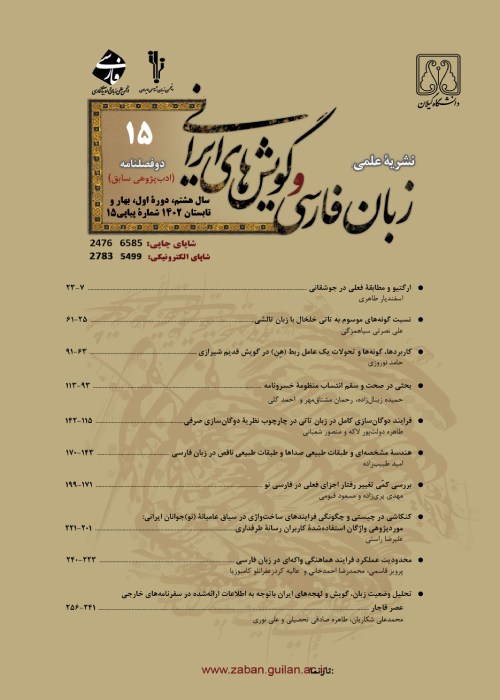Subjective and Objective Adjectives: A Typological Prototype Approach
Author(s):
Article Type:
Research/Original Article (دارای رتبه معتبر)
Abstract:
Introduction
The most basic elements of a language which play a key role in majority of syntactic theories and morphological analyses are “parts of speech” including “adjectives”, the subject of the present contribution. The sources of Persian traditional Grammar have divided adjectives into various categories such as subjective, objective, ability types and the like. However, a considerable challenge for defining and categorizing adjectives relates to the fact that the parts of speech (henceforth, POS) have extended marked grammatical functions besides their unmarked functions. Therefore, to describe and explain POS, we should resort to a theory positing that the members of a category are not equal. The present research seeks to provide answers to the following questions:1.How are ability adjectives associated with subjective and objective patterns? 2.Which feature(s) of prototypical adjectives do subjective and objective adjectives lack?
3.Which part(s) of speech result(s) from the categorical shift of subjective and objective adjectives and how do these adjectives differ from other types of adjectives?
Theoretical framework
This research has been conducted within the framework of Typological Prototype Theory (henceforth, TPT), which is a theory about categorization and has arisen from cognitive linguistics. Cognitive grammar posits that language is relative, and as Langacker (1987) puts, the linguistic system is not an all-or-nothing matter. The prototype theory was developed in the works of Brent & Key and also Rosch in the 1960s and 1970s, however it was Lakoff who first used it in relation to linguistic categories. In line with Cognitive Grammar, Croft (2001) developed the Radical Construction Grammar in the form of a theory based upon Typological Prototype Theory, according to which the prototypical function of POS occurs in unmarked functions, and the POS may also appear in non-prototypical or peripheral functions through structural coding. This point of view states that each grammatical category has central and peripheral members, with the central members having higher frequency, being less structurally coded, and showing a complete potential behavior.
By structural coding, we mean the use of morphemes to make a lexical category marked. Croft (2001) uses two criteria of structural coding and potential behavior for typological markedness. According to the former criterion, the marked value of a grammatical category has equal or greater morphemes than its unmarked value, while according to the latter criterion, one value of a conceptual category is grammatically more 'versatile' than the other. The grammatical behavior of the unmarked and the marked POS can be differentiated using the sub-criteria of behavioral potential criterion including comparability, function in attributive and predicative positions, and frequency of occurrence.
According to Croft (2001), there are constructions in all languages of the world for predication, reference and modification, which express the propositional acts needed by languages. We can use these propositional acts to identify the POS. Words that can fill in the positions of predication, reference and modification can be divided into semantic classes, and the basic propositional act functions of strengths of the prototypes include action, object and property.
Methodology
This is a descriptive – analytical research conducted using the content analysis method. The adjectives used as the raw data were collected by the researchers and the frequency of their occurrence were examined both in the Persian Language Database (PLDB) and Bijankhan Corpus. Considering the diverse texts and words used in these corpuses, it is expected that they are appropriate representatives of the texts and words used in Contemporary Persian. It is noteworthy that considering the practical limitations and the impossibility of analyzing all the selected adjectives, the researchers selected and analyzed a limited number of action adjectives and tried to select basic adjectives which are more frequently used and do not belong to a specific colloquial or written style.
Results and Discussion
The present research showed that subjective and objective adjectives belong to the <modification, action> class of adjectives and are non-prototypical or peripheral adjectives. Examining the semantic and syntactic features of ability adjectives and comparing them with the subjective and objective adjectives, the researchers concluded that ability adjectives can be placed within either subjective or objective types of adjectives depending on their construction. This research also revealed that subjective and objective adjectives cannot be considered prototypical adjectives based on the structural coding criterion and the comparability sub-criterion. This conclusion was strongly confirmed through the frequency of these adjectives in the PLDB and Bijankhan Corpus. The present contribution also exhibited that the categorical shift of the Persian subjective and objective adjectives is toward the lexical category of noun and that the changes of these adjectives are different from the adjectives denoting a property or object.
Conclusions and Suggestions
This research demonstrated that the TPT is able to account for the behavioral differences of the adjectives denoting property, action and object, but is incapable of explaining the behavioral differences of the sub-categories of these classes of adjectives. To reach more reliable conclusions, a typological- functional theory is needed to differentiate between all members of a category by considering all morphological, syntactic, semantic, stylistic and pragmatic criteria. Further research can analyze other types of Persian adjectives including those denoting object and property within the framework of the TPT and determine the degree to which they are close to or distant from prototypical adjectives. It is also suggested that future researches examine other POS within this framework to specify the degree of prototypicality, thereby taking a step toward bridging the gaps in relation to the POS in Persian.
Keywords:
Language:
Persian
Published:
Journal of Persian language and Iranian dialects, Volume:3 Issue: 2, 2019
Pages:
93 to 112
magiran.com/p2008721
دانلود و مطالعه متن این مقاله با یکی از روشهای زیر امکان پذیر است:
اشتراک شخصی
با عضویت و پرداخت آنلاین حق اشتراک یکساله به مبلغ 1,390,000ريال میتوانید 70 عنوان مطلب دانلود کنید!
اشتراک سازمانی
به کتابخانه دانشگاه یا محل کار خود پیشنهاد کنید تا اشتراک سازمانی این پایگاه را برای دسترسی نامحدود همه کاربران به متن مطالب تهیه نمایند!
توجه!
- حق عضویت دریافتی صرف حمایت از نشریات عضو و نگهداری، تکمیل و توسعه مگیران میشود.
- پرداخت حق اشتراک و دانلود مقالات اجازه بازنشر آن در سایر رسانههای چاپی و دیجیتال را به کاربر نمیدهد.
In order to view content subscription is required
Personal subscription
Subscribe magiran.com for 70 € euros via PayPal and download 70 articles during a year.
Organization subscription
Please contact us to subscribe your university or library for unlimited access!



